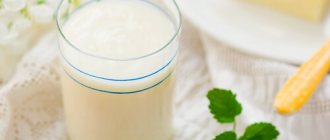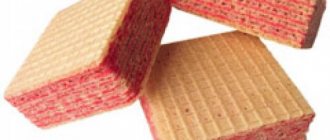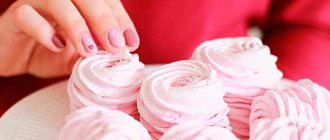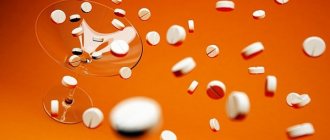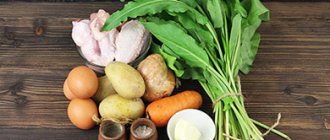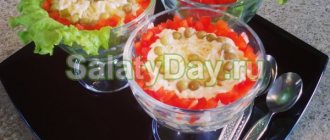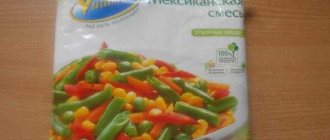Properties of the loaf
Nutritional value and composition | Vitamins | Minerals
How much does a loaf cost (average price for 1 piece)?
Moscow and Moscow region.
30 rub.
The loaf, a famous bakery product, got its name from the French word bâton, which means stick or block. This analogy was not made lightly. The fact is that the first loaves began to be made, like baguettes, in long, oblong and thin shapes. A little later, the loaf “grew fat” and acquired its modern appearance. Moreover, in the Middle Ages in France, gingerbread cookies called loaves were baked from hard dough, often adding honey, nuts or dried fruits.
Currently, a loaf is called improved white bread, which has an oblong shape. What is noteworthy is that the term loaf is used to refer to sausage products of an elongated shape, for example, a stick or a loaf of sausage. There are several main criteria by which a given bakery product is classified and assigned to one or another grade and type of loaf.
There is a distinction based on the set of ingredients that make up the loaf, taking into account, for example, the type and type of flour. Raisins or dried apricots are often added to loaves. These loaves are sweet and pleasant to the taste, their dough is airy and resembles a bun. Freshly baked raisin loaves with a crispy crust can be a wonderful treat for family tea parties.
There are also city, student, Moscow region, capital, special and table loaves. The latter, by the way, are considered the most high-calorie. Loaves vary in size; there are products weighing 300, 400-450 and 500 grams, length from 18 to 70 cm, and width from 5 to 13 cm. The loaf can be sliced and packaged. There are types of loaves specific in shape. For example, loaves with rounded or sharp ends.
The benefits of bread product
Having considered the energy value of various types of baked goods, it is necessary to present its benefits so that readers can decide whether to consume it daily. The benefits of the product are indicated by the composition presented in the table.
| VITAMINS | CONTENTS, MG | MINERALS | CONTENTS, MG |
| Kholin | 60 | Chlorine | 680 |
| Vitamin E | 2,3 | Sodium | 400 |
| Vitamin B3 | 2 | Potassium | 244 |
| Vitamin B5 | 0,55 | Phosphorus | 194 |
| Vitamin B6 | 0,2 | Magnesium | 57 |
| Vitamin B2 | 0,09 | Sulfur | 56 |
| Vitamin B9 | 0,03 | Calcium | 33 |
| Vitamin B1 | 0,02 | Silicon | 5,5 |
| Vitamin A | 0,003 | Iron | 4,5 |
| Vitamin H | 0,002 | Zinc | 1 |
The benefits of bread lie in the content of healthy amino acids, complex carbohydrates and fiber. The substances presented can normalize intestinal function and reduce cholesterol levels in human blood. But the consumption of baked goods should be in moderation, because otherwise you may encounter increased intestinal gas formation. This in most cases occurs when consuming large quantities of wheat or products with bran.
| Name | Calorie content per 100 g |
| Wheat flour loaf | 235 kcal |
| Pancake flour (pancake flour) | 333 kcal |
| Pancake with cottage cheese | 162 kcal |
| Pancake with mushrooms | 200 kcal |
| Pancake with meat | 186 kcal |
| Pancake with chicken and rice | 169 kcal |
| Butter bun | 300 kcal |
| Hot dog bun | 266 kcal |
| Burekasi with cabbage | 393 kcal |
| Burekas with liver | 404 kcal |
| Burekas with jam | 412 kcal |
| Burekas with meat | 373 kcal |
| Burekasi with onion and egg | 354 kcal |
| Croissant with caramel | 298 kcal |
| Croissant with cabbage | 377 kcal |
| Coffee croissant | 346 kcal |
| Wheat flour | 334 kcal |
| Rye bran | 212 kcal |
| Wheat bran | 260 kcal |
| Blueberry pie (pie with blueberries) | 196 kcal |
| Strawberry pie (pie with strawberries) | 221 kcal |
| Pie with lingonberries | 242 kcal |
| Fried pie with liver | 336 kcal |
| Pie fried with onion and egg | 248 kcal |
| Pie with cabbage | 246 kcal |
| Pie with fish | 227 kcal |
| Pie in Ural style | 178 kcal |
| Drying | 341 kcal |
| Cream crackers | 398 kcal |
| Rye crackers (Finnish) | 320 kcal |
| Wheat-oat crackers (well done bread) | 295 kcal |
| Wheat-buckwheat crackers (well done bread) | 280 kcal |
| Puff pastry without yeast | 487 kcal |
| Crackers with cranberries (Doctor Korner) | 330 kcal |
| Cereal crackers (Doctor Korner) | 312 kcal |
| Black bread | 214 kcal |
| White wheat bread | 223 kcal |
| Borodino bread | 208 kcal |
| Chusovsky dark bread | 212 kcal |
| Malt bread | 281 kcal |
| Kaiser bread | 271 kcal |
| Corn bread with seeds | 290 kcal |
| Rye bread made from peeled flour | 189 kcal |
| Rye bread made from wallpaper flour | 181 kcal |
Composition of a standard loaf
A loaf is baked from whole ground grain, which saturates the baked goods with B vitamins, macro- and microelements. The standard composition of this bread includes flour, margarine, sugar, salt, water and yeast. In production, the surface of the loaf is lubricated with a solution to add shine and cuts are made on the surface. The type of loaf depends on the following factors:
- Ingredients and type of flour.
- Raw materials of plant origin, fats and vitamins.
- Additives and flavor substitutes (raisins, nuts, sesame seeds, various cereals).
- Calorie content (the maximum permissible amount of sugar is from 5 to 50g).
- Water – 34.
- Proteins – 7.5.
- Fats – 2.9.
- Carbohydrates – 50.9.
- Kcal – 264.
- Water – 35.1.
- Proteins – 7.5.
- Fats – 2.6.
- Carbohydrates – 50.6.
- Kcal – 261.
- Water – 15.
- Proteins – 9.2.
- Fats – 2.8.
- Carbohydrates – 51.4.
- Kcal – 273.
- Water – 34.1.
- Proteins – 7.7.
- Fats – 0.8.
- Carbohydrates – 50.2.
- Kcal – 243.
Characteristics and quality of the loaf
A high-quality loaf has a golden brown crust, delicate taste and undeformed shape. The weight of one loaf ranges from 300 to 500g. The production produces loaves cut into pieces.
A loaf is an improved white bread that has an oblong shape. There are certain criteria by which a given bakery product is classified and assigned to one or another type and grade of loaf.
Dried apricots and raisins are added to the loaves. These loaves are pleasant to the taste, sweet and airy, reminiscent of a bun. These loaves are a wonderful treat for morning breakfast with tea or coffee.
There are city loaves, student loaves, metropolitan loaves, sliced loaves, Moscow loaves, with wheat bran, etc. They differ in size, composition and weight. There are also loaves with sharp or rounded ends.
In laboratory conditions, the loaf is tested for moisture, acidity and porosity. The content of food additives, preservatives, and flavor enhancers in the product, if any, is also determined.
Varieties and chemical composition of loaf
The loaf contains a set of elements vital for humans. This is a large amount of carbohydrates, such as starch, fiber, sugar, as well as fats, proteins, potassium, magnesium, iron and B vitamins. By eating a loaf, a person gets a boost of energy for the whole day. The fiber contained in the loaf is not digested, so it perfectly cleanses the intestines. But it should be noted that excessive consumption of this product can lead to obesity. Also, white bread should not be consumed if you have diabetes.
Made from 1st grade flour. It contains micro- and macroelements: chlorine, sodium, phosphorus, manganese, cobalt, vanadium and vitamins necessary for the body: PP (niacin), vitamin B1 (thiamine), F (TE.)
100g of sliced loaf contains:
- Water – 34.
- Proteins – 7.5.
- Fats – 2.9.
- Carbohydrates – 50.9.
- Kcal – 264.
For those who follow a diet and count calories and the percentage of proteins, fats and carbohydrates, you need to know that a gram of protein contains 4 Kcal, a gram of carbohydrates - 4 Kcal, a gram of fat - 9 Kcal.
This loaf is produced in accordance with GOST 27844-88 and contains premium flour, salt, sugar, Table margarine. The shape of this loaf is oblong-oval with two longitudinal cuts. The color is light yellow, the crumb is elastic without voids. The weight of this loaf is 400g, length – from 24 to 28cm, and width – from 9 to 11cm.
100g of Podmoskovny loaf contains:
- Water – 35.1.
- Proteins – 7.5.
- Fats – 2.6.
- Carbohydrates – 50.6.
- Kcal – 261.
Produced in accordance with GOST TU9115-392-36530682-2005, weight – 300g. This type of loaf is baked from premium wheat flour, water, wheat bran, baking powder, pressed yeast, salt, sunflower oil, salt, sugar. Bran loaf is a healthy food product. It contains fiber, disaccharides, saturated fatty acids, as well as vitamins B, K, PP. The loaf is rich in minerals and trace elements:
- copper, selenium, manganese, zinc, iron;
- magnesium, calcium, phosphorus, potassium, sodium.
A loaf of bran contains a large amount of dietary fiber, which regulates intestinal function, adsorbs and removes toxins. Eating this loaf reduces appetite, promotes satiety, and prevents atherosclerosis. This loaf is an indispensable product for overweight people.
100g of loaf with wheat bran contains:
- Water – 15.
- Proteins – 9.2.
- Fats – 2.8.
- Carbohydrates – 51.4.
- Kcal – 273.
Produced in accordance with GOST 27844-88 from premium wheat flour, pressed yeast, sugar, salt, drinking water and Oton baking improver. The weight of this loaf is 400g, shelf life is 3 days.
100g of Stolichny loaf contains:
- Water – 34.1.
- Proteins – 7.7.
- Fats – 0.8.
- Carbohydrates – 50.2.
- Kcal – 243.
The metropolitan loaf is one of the most beloved among consumers. Delicious, crispy and flavorful, it is wonderful as a sandwich with sausage, bacon, butter and cream cheese, or with jam and chocolate cream. Toast made from a stale loaf is wonderful. They are especially useful for those who have a stomach disease and cannot eat the loaf fresh.
All of the above applies to almost all types and varieties of loaves. For those who are watching their figure, but do not have problems with gastrointestinal diseases, it is better to eat a loaf with wheat bran. It is recommended to consume the loaf in the morning - it is an excellent source of energy, vitamins and microelements for the whole day.
CHEMICAL COMPOSITION AND NUTRITIONAL ANALYSIS
Nutritional value and chemical composition of “Sliced loaf made from premium flour (bread)”.
The table shows the nutritional content (calories, proteins, fats, carbohydrates, vitamins and minerals) per 100 grams of edible portion.
| Nutrient | Quantity | Norm** | % of the norm in 100 g | % of the norm in 100 kcal | 100% normal |
| Calorie content | 262 kcal | 1684 kcal | 15.6% | 6% | 643 g |
| Squirrels | 7.5 g | 76 g | 9.9% | 3.8% | 1013 g |
| Fats | 2.9 g | 56 g | 5.2% | 2% | 1931 |
| Carbohydrates | 51.4 g | 219 g | 23.5% | 9% | 426 g |
| Organic acids | 0.2 g | ~ | |||
| Alimentary fiber | 2.5 g | 20 g | 12.5% | 4.8% | 800 g |
| Water | 34 g | 2273 g | 1.5% | 0.6% | 6685 g |
| Ash | 1.5 g | ~ | |||
| Vitamins | |||||
| beta carotene | 0.01 mg | 5 mg | 0.2% | 0.1% | 50000 g |
| Vitamin B1, thiamine | 0.11 mg | 1.5 mg | 7.3% | 2.8% | 1364 g |
| Vitamin B2, riboflavin | 0.03 mg | 1.8 mg | 1.7% | 0.6% | 6000 g |
| Vitamin B4, choline | 53 mg | 500 mg | 10.6% | 4% | 943 g |
| Vitamin B5, pantothenic | 0.3 mg | 5 mg | 6% | 2.3% | 1667 g |
| Vitamin B6, pyridoxine | 0.15 mg | 2 mg | 7.5% | 2.9% | 1333 g |
| Vitamin B9, folates | 28 mcg | 400 mcg | 7% | 2.7% | 1429 g |
| Vitamin E, alpha tocopherol, TE | 1.7 mg | 15 mg | 11.3% | 4.3% | 882 g |
| Vitamin H, biotin | 1.84 mcg | 50 mcg | 3.7% | 1.4% | 2717 g |
| Vitamin RR, NE | 2.1 mg | 20 mg | 10.5% | 4% | 952 g |
| Niacin | 0.9 mg | ~ | |||
| Macronutrients | |||||
| Potassium, K | 92 mg | 2500 mg | 3.7% | 1.4% | 2717 g |
| Calcium, Ca | 19 mg | 1000 mg | 1.9% | 0.7% | 5263 g |
| Silicon, Si | 2.2 mg | 30 mg | 7.3% | 2.8% | 1364 g |
| Magnesium, Mg | 13 mg | 400 mg | 3.3% | 1.3% | 3077 g |
| Sodium, Na | 427 mg | 1300 mg | 32.8% | 12.5% | 304 g |
| Sera, S | 58 mg | 1000 mg | 5.8% | 2.2% | 1724 g |
| Phosphorus, Ph | 65 mg | 800 mg | 8.1% | 3.1% | 1231 g |
| Chlorine, Cl | 713 mg | 2300 mg | 31% | 11.8% | 323 g |
| Microelements | |||||
| Iron, Fe | 1.2 mg | 18 mg | 6.7% | 2.6% | 1500 g |
| Cobalt, Co | 2 mcg | 10 mcg | 20% | 7.6% | 500 g |
| Manganese, Mn | 0.837 mg | 2 mg | 41.9% | 16% | 239 g |
| Copper, Cu | 135 mcg | 1000 mcg | 13.5% | 5.2% | 741 g |
| Molybdenum, Mo | 13.6 mcg | 70 mcg | 19.4% | 7.4% | 515 g |
| Chromium, Cr | 2.2 mcg | 50 mcg | 4.4% | 1.7% | 2273 g |
| Zinc, Zn | 0.744 mg | 12 mg | 6.2% | 2.4% | 1613 g |
| Digestible carbohydrates | |||||
| Starch and dextrins | 48.5 g | ~ | |||
| Mono- and disaccharides (sugars) | 2.9 g | max 100 g | |||
| Saturated fatty acids | |||||
| Saturated fatty acids | 0.5 g | max 18.7 g |
The energy value is 262 kcal.
Main source: Skurikhin I.M. and others. Chemical composition of food products. .
** This table shows the average levels of vitamins and minerals for an adult. If you want to know the norms taking into account your gender, age and other factors, then use the My Healthy Diet app.
Loaf composition
The taste and calorie content of the loaf depends on the composition of the ingredients of the product. Often, different recipes suggest using from 5 to 50 grams of sugar per kilogram of flour in loaf dough. This is a fairly large difference, which determines the calorie content of the loaf, as well as its type. There are sweet, fresh, and salty loaves.
Typically, the loaf contains premium, first and second grade wheat flour, salt, vegetable oil or margarine, sugar, water and yeast. You can easily make a loaf of bread at home. However, this will require either a universal bread maker or a special mode for baking baked goods in the oven.
Almost all types of loaves have longitudinal cuts on their surface. This design makes the baked product unique and easy to remember. Before baking, loaves produced in the food industry are greased with a special solution, which adds shine to the crust of the baked bread.
The quality of the loaves is assessed by the following parameters: the shape of the product (there should be no deformations), the color of the surface of the loaf, as well as the crumb. In laboratory conditions, the loaf is tested as a food product for acidity, moisture, porosity, and the content of preservatives, food additives and flavor enhancers in the chemical composition of the product, if any, is determined.
Benefits and harms
In moderate quantities (1-2 slices per day), the loaf has health benefits, namely:
- the body is saturated with energy;
- the feeling of hunger is satisfied;
- food satiation comes faster;
- bowel function improves;
- mood improves.
During breastfeeding, mothers can eat a small amount of the product, as the body needs carbohydrates and energy.
You can give a child white bread from 7 months, but it is not recommended to introduce a loaf of bread into the diet before the baby reaches 3 years of age, since the product contains margarine.
Abuse of baked goods can lead to:
- bloating;
- intestinal disorder;
- obesity.
Eating the loaf is contraindicated for people with gluten allergies, intolerance to the product, pregnant women, as well as those who suffer from increased gas formation or gastrointestinal diseases.
For overweight people, it is better to exclude white bread from the diet completely.
Caution, dangerous
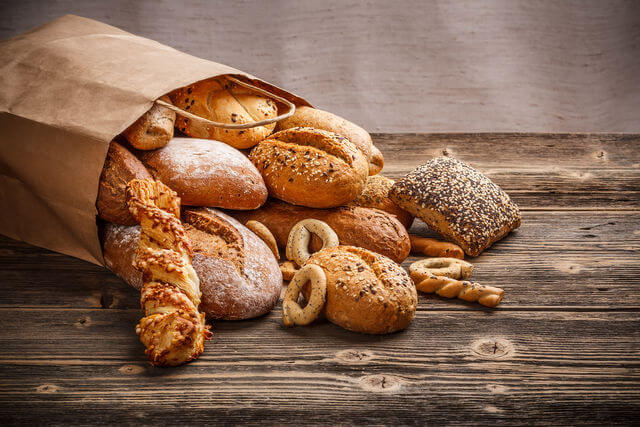
Despite many positive qualities, this unusual version of bread has several significant drawbacks. The most significant of them is the manufacturer’s dishonest attitude towards the finished product. Adding artificial ingredients to preserve a fresh appearance for a longer period of time or questionable fats are common reasons that spoil health.
Because of this, even inexperienced housewives try to make homemade loaf on their own. This way they will be sure that they will be able to taste deliciousness without harmful ingredients. Another red light is obesity. People with abnormal metabolism and fat deposits should not eat the product, so as not to aggravate the situation. It is especially important to refrain from repeated heat treatment of an already finished product, for example, by making croutons out of it in a frying pan.
In addition to the obvious harm, there is also hidden harm. It is based on the use of yeast. They can undermine the health of the digestive system. Because each piece of dough is baked in the oven at fairly high temperatures and then kept for quite a long period of time, it turns into a potential killer.
Once the growing yeast enters the stomach, it begins the active stage of reproduction. This leads to the fact that the intestinal microflora is subjected to serious tests. This unpleasant picture ends with a general suppression of the immune system, an allergic reaction, and dysbacteriosis.
Experts insist that this cannot happen in production, but if safety regulations are deviated for some reason, such an outcome is indeed possible. Moreover, the end consumer will not suspect anything at all.
The quality of flour can also affect your state of health. Especially in cases where we are talking about a high-grade analogue. Although such a variation costs more than other proposals, it has almost no practical benefit. Refined flour acts on organs and tissues according to an identical algorithm, which encourages the development of diseases of the following systems:
- endocrine;
- cardiovascular;
- digestive.
If you regularly eat this way, you may even be at risk of cancer.
